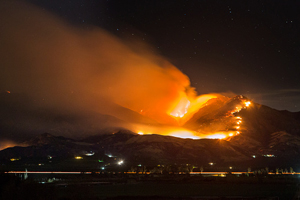 "Field Notes" is an occasional
"Field Notes" is an occasional Connect
column covering practical and philosophical issues facing admissions and registrar professionals. The columns are authored by various AACRAO members. If you have an idea for a column and would like to contribute, please send an email to the editor at connect@aacrao.org.
by Marlo J. Waters, Registrar, Pacific Union College
One Sunday evening last October, our campus community was suddenly rocked by repeated sirens and alerts. A strong windstorm and multiple wildfires converged to create a night full of panic and confusion for several counties, including our own Napa county. We didn’t know it at the time, but this was the beginning of a multiple-week ordeal that has become known as the “Northern California Firestorm.” And while our campus was never in immediate danger, in the interest of safety we closed classes for a week and evacuated all students from the campus.
When the smoke cleared and everyone returned, we were immensely grateful for the blessings of safety and preservation of our physical facilities. And yet we faced the daunting task of re-starting the term after a week-long suspension of classes under highly stressful circumstances. Several members of our team looked for resources and guidance. We soon found that there was a noticeable lack of advice related to this topic. This article shares some of the lessons that we learned through our experience.
"And yet we faced the daunting task of re-starting the term after a week-long suspension of classes under highly stressful circumstances."
Make short term plans -- and expect them to change.The situation rapidly evolved and changed over the course of several weeks, with news reports seemingly as erratic and unpredictable as the wind and the flames. We constantly adjusted and readjusted our plans in order to respond to this reality. When senior administration decided to evacuate the campus, we had no idea when we would return. As a registrar, I am accustomed to scheduling and long-term planning. Those concepts went out the window and I had to help my team adjust to the concept of planning day-by-day.
Reach out to peers
There were multiple other campuses that also evacuated in our immediate area. Talking with professional counterparts at those institutions helped us develop plans and calibrate them. We had to create “best practices” as we went, and it was invaluable to have the advice of others during this process. It also helped provide consistency for students, many of whom were taking a class at a local community college while also being enrolled at our institution.
Flexibility, flexibility, flexibility
Once we did resume classes, our professors had lost a week of instruction. They had to revise their instructional plans in order to cover their material in the reduced timeframe. The Registrar’s Office worked with the Academic Standards Committee and the Faculty Senate to identify areas for policy flexibility to accommodate this work. For example, we extended the final grade deadline and allowed faculty to use their final exam slot for instruction, if desired. We also delayed the withdrawal deadline and were intentionally generous in reviewing late withdrawal petitions. Our overall goal was to uphold the integrity of the academic program while also recognizing the need for policy flexibility based on the extreme circumstances.
Consistency, consistency, consistency
Even though we were intentionally flexible in certain areas, we were also careful to be consistent. “Normality” had been ripped away, and many people expressed that they felt adrift and unsettled. Once classes resumed, our office worked hard to provide a sense of consistency and certainty with regards to functional tasks. This is, of course, a place where the Records Office can excel. We communicated out to campus via email and other communication forums, clearly outlining deadlines, procedures, and policy. Students and faculty understood the guidelines that would govern the remainder of their term, and we were told that this was a sense of comfort to many. In the midst of uncertainty, they were relieved to get solid answers regarding functional topics.
Community and care
Everyone was grateful for our safe return to an intact campus, but we were also traumatized. Our students, our staff, and our faculty experienced a natural disaster, and it takes time to recover and heal. It felt strange to return to “normalcy” after the craziness of the past several days. “Business as usual” was not an option -- we had to attend to the emotional trauma and allow people time to recover. Of course, our institution provided various support options for members of the campus community. But campus administrators and department directors also had a role to play in the healing process. It was important to be caring and calm with people during interactions, recognizing that many people were emotionally raw. My own expectations for my staff were different during the first weeks back- productivity was down and people spent a fair amount of time talking and processing their personal experiences. And that was OK. With time, things returned to “normal” and standard levels of productivity have resumed.
I sincerely hope that your campus never experiences a serious natural disaster. And yet, if it does, I hope these lessons learned are helpful to you and your community. Natural disasters force us to rethink our priorities in a sudden and drastic way. And yet, life keeps marching on despite the challenging circumstances. As registrars, we have the ability to service our campus in meaningful ways during unexpected and traumatic events.